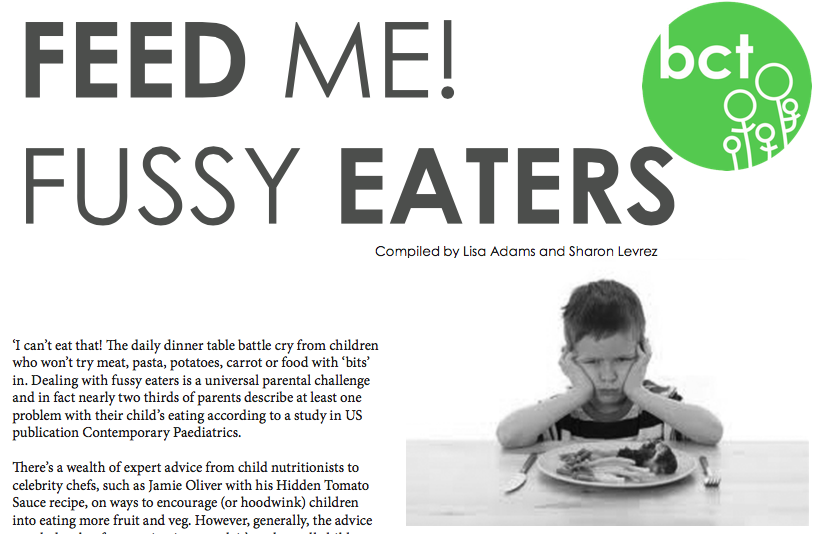‘I can’t eat that! The daily dinner table battle cry from children who won’t try meat, pasta, potatoes, carrot or food with ‘bits’ in. Dealing with fussy eaters is a universal parental challenge and in fact nearly two thirds of parents describe at least one problem with their child’s eating according to a study in US publication Contemporary Paediatrics.
There’s a wealth of expert advice from child nutritionists to celebrity chefs, such as Jamie Oliver with his Hidden Tomato Sauce recipe, on ways to encourage (or hoodwink) children into eating more fruit and veg. However, generally, the advice concludes that fussy eating is normal, it’s a phase all children go through, and they will grow out of it, but how do you cope while they are right in the middle of it and every meal time becomes a battleground?
Top Ten Tips for Parents
from Australian nutritionist Lisa Guy www.bodyandsoul.com.au
- 1. Try to be patient and stay calm. Mealtimes should be fun and relaxed.
- Continue offering new foods each meal. You may need to offer a food up to 10 times or more before your child will try it.
- Serve their favourite veggies. If your child will only eat two or three different veggies, always serve them for dinner, along with a small piece of some new veggie to try.
- Get creative in the kitchen. Make meals look fun and interesting. Try cutting your toddler’s sandwiches into shapes with a cookie cutter, cut fruit into balls and make food faces (peas for hair, mashed potato for the face, a carrot stick for the mouth). You can also buy plates with colourful designs.
- Be a good role model for your kids. Try to all sit down as a family together for at least one meal a day. Seeing their parents eat a healthy, well-balanced diet will encourage healthy eating habits in kids.
- Give your child smaller portions. You can always give them more if they are still hungry. A large serving may look too daunting.
- Don’t force your child to eat something they don’t like. This will make them less likely to eat it. I see adults in my clinic who won’t eat certain veggies because their parents forced them to eat them when they were young.
- Try not to make a fuss when your child refuses to eat something. Just try the food again the next day or in a couple of days’ time.
- Make sure your toddler doesn’t fill up on snacks before a main meal. When kids are hungry they are more likely to try something new.
- Avoid bribery with sweet treats. This may glorify less healthy options. Try using positive reinforcement – tell them how wonderful it is that they have tried something new, and how big and strong they will grow.
We also asked some mums on the BCT Experiences Register to share their personal strategies for coping with fussy eaters:
‘I have one child who I would describe as a fussy eater who was fussy from day one and unfortunately I made all the mistakes, making her even more fussy. What she ate one day she would turn her nose up at the next. It was all about control and attention. I would generally give her things she liked, while keeping the menu balanced and varied. As we know, this is a luxury you can’t afford when you have more than one child. If you have three or four it’s impossible. Once she was at school, eating with other children, and I stopped letting her choose her meals all the time, she eventually became less fussy. She now eats well and will try just about anything, but resorts to fussy eating when stressed or in need of attention. (Like right now she is refusing to have sandwiches in her packed lunch). But I know I just have to stay strong and she will come around in the end.’ SL
‘I agree that it is often just a very tiresome phase, especially around 2.5 years, and that a toddler will never starve himself. Don’t pit main against dessert (banana with custard is quite OK though). Try serving what you really want them to eat next to the other option. Tastes evolve so keep trying even when they won’t eat something. Express how much you love your broccoli. Don’t make it a battleground or it will just last longer! Always try to add a dash of simple fun like a plate or placemat they love or put a pea face in Mr Mash. My mantra became: This too shall pass!’ CV
‘I found that social eating only works if you are all eating the same thing at the same time. Right now C (15 months) seems fussy because she refuses all of her own food, that’s because she wants ours. So I can only give her baby food if she eats on her own first; if we want to all eat together then she has to have what we’re having, in the same format – mashing or whatever doesn’t wash with her.’
‘I make my husband take some of everything as well, even the things he doesn’t eat, so we don’t accidentally project our own food dislikes onto the kids. And I found that boys in particular will try almost anything if it comes from their mother’s plate!’ GM
‘I’d recommend reading the book ‘My Child Won’t Eat! (pub La Leche League International 2005)
It’s calming, soothing, informed and relaxed.’ KM
‘Tripp Trapp chairs were a godsend for my younger children as they ate from the table rather than a high chair tray and learnt to eat ‘normally’ much more quickly than my older children had. Focusing on talking and having a nice time at the table is less stressful than monitoring every mouthful. Look at what the child is eating over the whole day or week. Some meal times D hardly eats but then later on will eat loads, so over the day it balances out. Getting him to hold his own cutlery as soon as he could also worked. He liked being in control of what he was eating, and stabbing things with a fork is fun!’ LB
Compiled by Lisa Adams and Sharon Levrez
This article was first published in the November 2012 edition of the BCT’s Small Talk magazine.






